2017 TOYOTA MIRAI charging
[x] Cancel search: chargingPage 80 of 464

802. Fuel cell vehicle
MIRAI_OM_USA_OM62023U
■Sounds unique to the fuel cell vehicle
Due to the design of your fuel cell vehicle, there are various relays, valves
and pumps which under normal driving conditions will produce sounds. This
is a normal characteristic of the vehicle and does not indicate a malfunction.
Furthermore, way of hearing may differ based on usage environment or con-
dition.
Noticeable soundsSource of the sounds
Clunking, clicking and clack-
ingOperation of relays and hydrogen tank
valves
Sounds may come from under the floor or
behind the rear seats.
(Sounds may be heard when starting the
fuel cell system.)
KnockingThe parking lock is engaged
Sounds may come from the motor
compartment.
(Sounds may be heard when press the P
position switch or stopping the fuel cell
system.)
Whooshing, squealingGas is flowing through the nozzle and
valvesSounds may come from behind the rear
seats, or from the dispenser hose/nozzle.
(Sounds may be heard when filling the
fuel.)
• High pitch sound
• Gurgle sound
• Pulsing soundOperation of the pumpsSounds may come from the motor com-
partment or under the front seats.
(In particular, sounds may be heard when
starting the fuel cell system, accelerating
from a stop, or press the H
2O switch. The
sound may be louder when in Br mode or
when the vehicle decelerates during
dynamic radar cruise control.)
Humming soundOperation of the pumps are speeding up
Sounds may come from the motor com-
partment or under the front seats.
(In particular, sounds may be heard when
accelerating or decelerating.)
Whooshing sound Operation of the hydrogen injectorSounds may come from under the front
seats or behind the rear seats.
(In particular, sounds may be heard when
starting the fuel cell system, driving at low
speeds, or charging the traction battery.)
Page 81 of 464
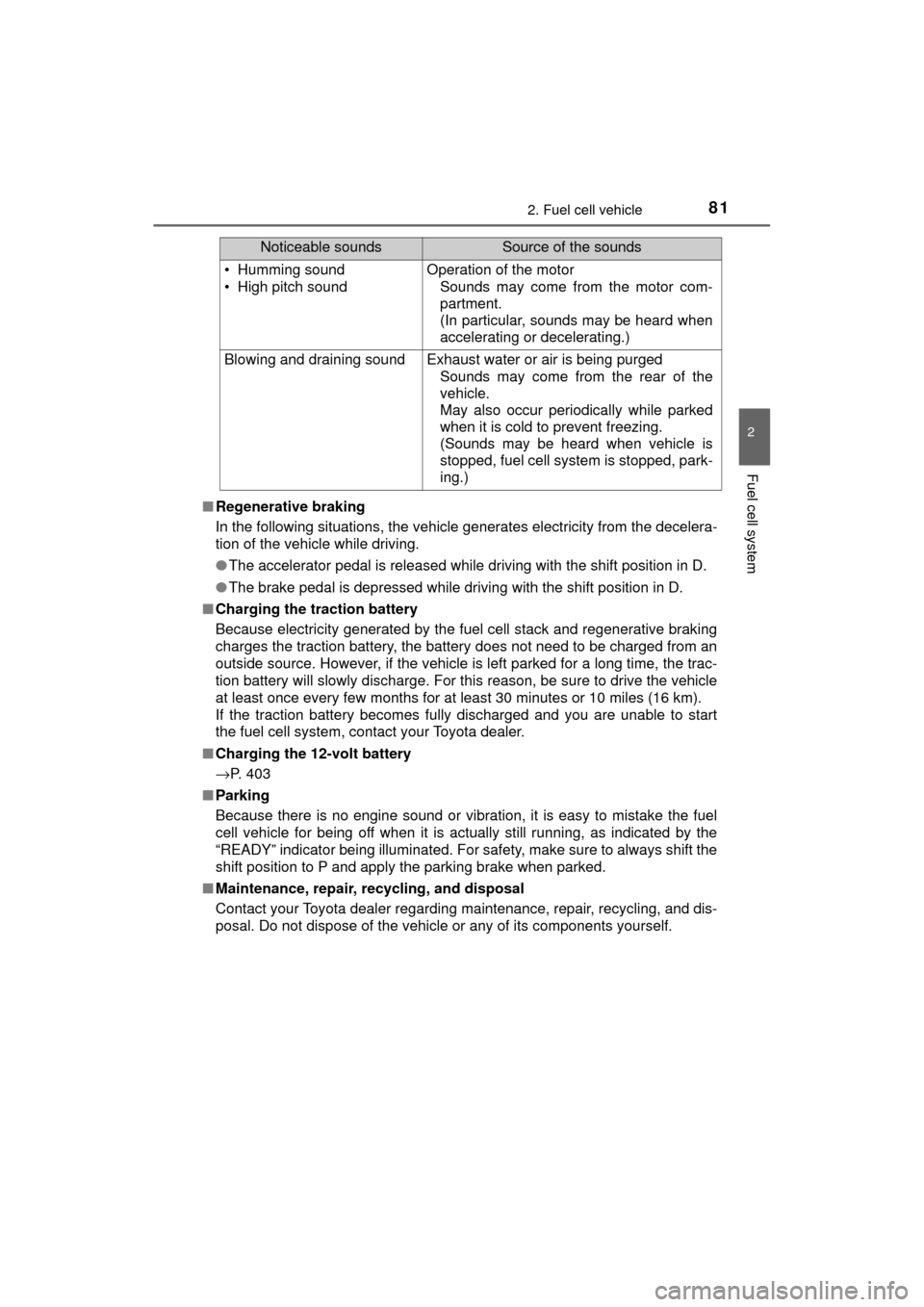
812. Fuel cell vehicle
2
Fuel cell system
MIRAI_OM_USA_OM62023U■
Regenerative braking
In the following situations, the vehicle generates electricity from the decelera-
tion of the vehicle while driving.
●The accelerator pedal is released while driving with the shift position in D.
● The brake pedal is depressed while driving with the shift position in D.
■ Charging the traction battery
Because electricity generated by the fuel cell stack and regenerative braking
charges the traction battery, the battery does not need to be charged from an
outside source. However, if the vehicle is left parked for a long time, the trac-
tion battery will slowly discharge. For this reason, be sure to drive the vehicle
at least once every few months for at least 30 minutes or 10 miles (16 km).
If the traction battery becomes fully discharged and you are unable to start
the fuel cell system, contact your Toyota dealer.
■ Charging the 12-volt battery
→P. 403
■ Parking
Because there is no engine sound or vibration, it is easy to mistake the fuel
cell vehicle for being off when it is actually still running, as indicated by the
“READY” indicator being illuminated. For safety, make sure to always shift the
shift position to P and apply the parking brake when parked.
■ Maintenance, repair, recycling, and disposal
Contact your Toyota dealer regarding maintenance, repair, recycling, and dis-
posal. Do not dispose of the vehicle or any of its components yourself.
• Humming sound
• High pitch soundOperation of the motor
Sounds may come from the motor com-
partment.
(In particular, sounds may be heard when
accelerating or decelerating.)
Blowing and draining soundExhaust water or air is being purgedSounds may come from the rear of the
vehicle.
May also occur periodically while parked
when it is cold to prevent freezing.
(Sounds may be heard when vehicle is
stopped, fuel cell system is stopped, park-
ing.)
Noticeable soundsSource of the sounds
Page 99 of 464

993. Instrument cluster
3
Instrument cluster
MIRAI_OM_USA_OM62023U
Warning lights inform the driver of malfunctions in the indicated vehi-
cle’s systems.
Warning lights
*1
Hydrogen leak warning
light ( →P. 369)*1
Slip indicator ( →P. 370)
*1
Brake system warning
light (→P. 369)Parking brake warning
light (→P. 371)
*1
Charging system
warning light ( →P. 369)Open door warning light
(→P. 371)
*1High coolant
temperature warning
light ( →P. 369)Low fuel level warning
light (→P. 371)
*1
Brake system warning
light (→P. 369)Driver’s and front
passenger’s seat belt
reminder light ( →P. 3 7 1 )
*1
SRS warning light
(→P. 370)*1
Master warning light
(→P. 371)
*1
ABS warning light
(→P. 370)*1
Tire pressure warning
light ( →P. 371)
*1
(Red/
Ye l l o w )
Electric power steering
system warning light
( →P. 370)*3Brake Override System/
Drive-Start Control
warning light ( →P. 372)
*1, 2
PCS warning light
(→P. 370)
Page 109 of 464
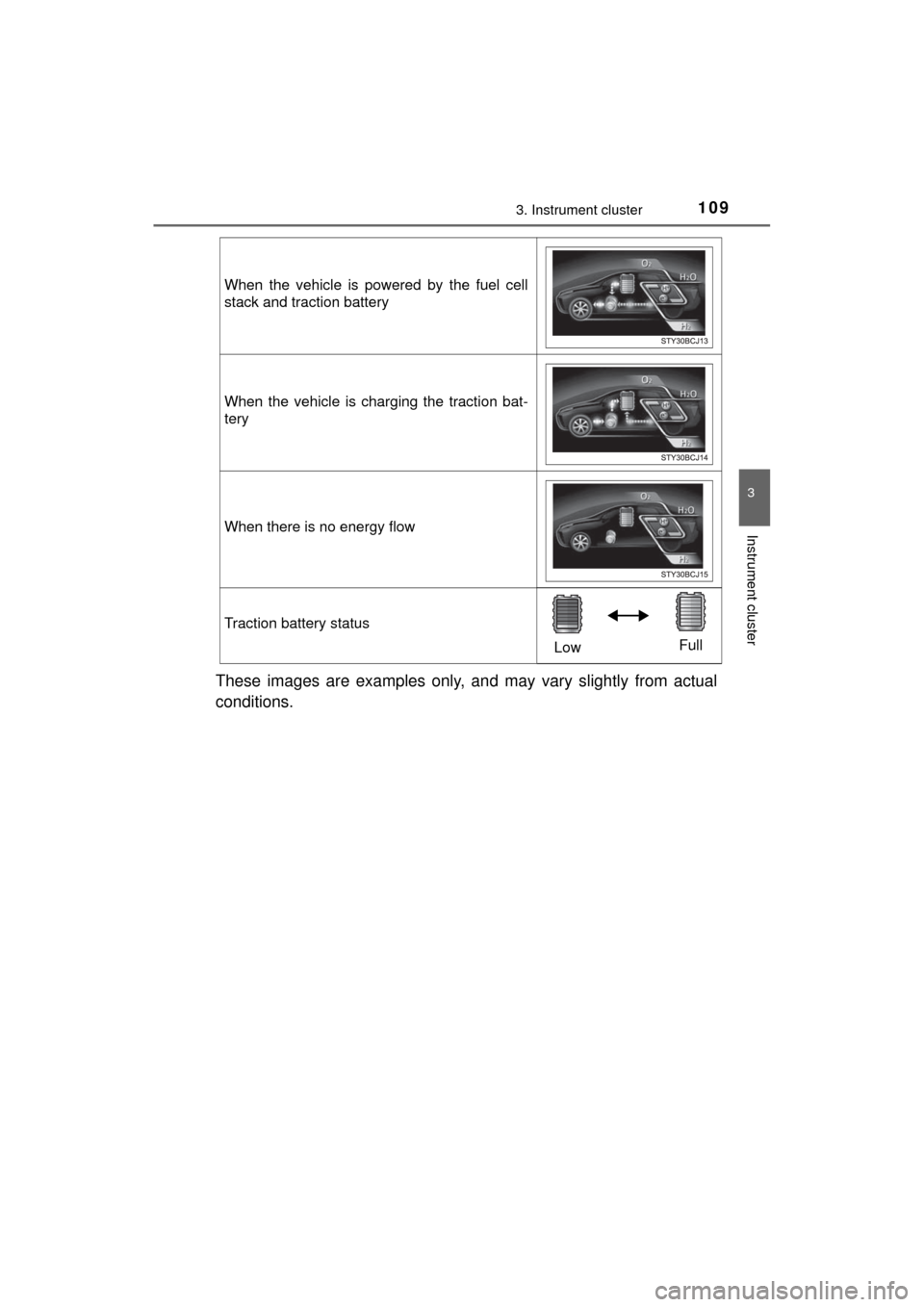
1093. Instrument cluster
3
Instrument cluster
MIRAI_OM_USA_OM62023U
These images are examples only, and may vary slightly from actual
conditions.
When the vehicle is powered by the fuel cell
stack and traction battery
When the vehicle is charging the traction bat-
tery
When there is no energy flow
Traction battery status
LowFull
Page 118 of 464
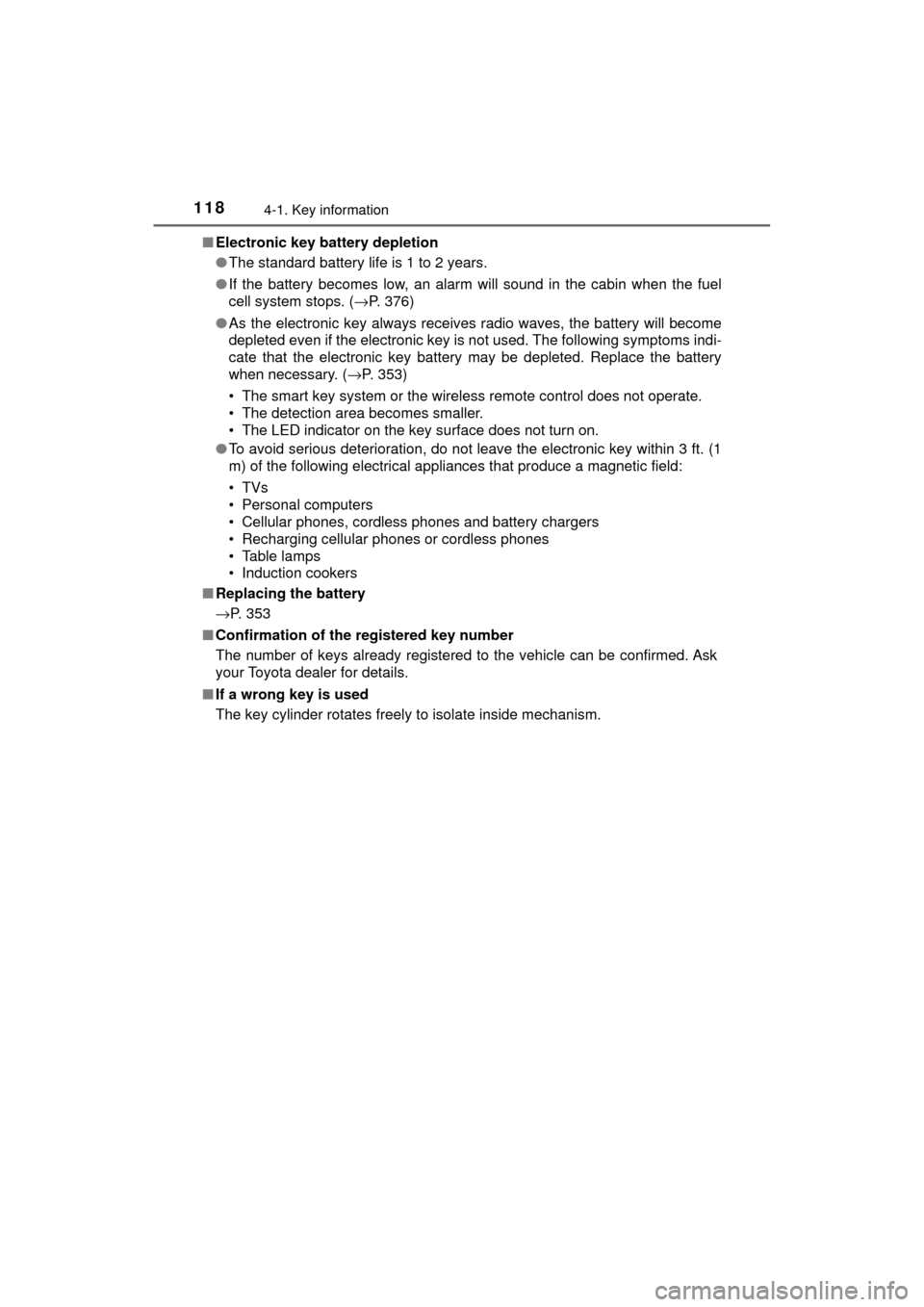
1184-1. Key information
MIRAI_OM_USA_OM62023U■
Electronic key battery depletion
●The standard battery life is 1 to 2 years.
● If the battery becomes low, an alarm will sound in the cabin when the fuel
cell system stops. ( →P. 376)
● As the electronic key always receives radio waves, the battery will become
depleted even if the electronic key is not used. The following symptoms indi-
cate that the electronic key battery may be depleted. Replace the battery
when necessary. ( →P. 353)
• The smart key system or the wireless remote control does not operate.
• The detection area becomes smaller.
• The LED indicator on the key surface does not turn on.
● To avoid serious deterioration, do not leave the electronic key within 3 ft. (1
m) of the following electrical appl iances that produce a magnetic field:
•TVs
• Personal computers
• Cellular phones, cordless phones and battery chargers
• Recharging cellular phones or cordless phones
• Table lamps
• Induction cookers
■ Replacing the battery
→P. 353
■ Confirmation of the registered key number
The number of keys already registered to the vehicle can be confirmed. Ask
your Toyota dealer for details.
■ If a wrong key is used
The key cylinder rotates freely to isolate inside mechanism.
Page 189 of 464

1895-3. Operating the lights and wipers
5
Driving
MIRAI_OM_USA_OM62023U■
Automatic light off system
●When the headlights are on: The headlights and tail lights turn off 30 sec-
onds after a door is opened and closed if the power switch is turned to
ACCESSORY mode or turned off. (The lights turn off immediately if
on the key is pressed after all the doors are locked.)
● When only the tail lights are on: The tail lights turn off automatically if the
power switch is turned to ACCESSORY mode or turned off and the driver’s
door is opened.
To turn the lights on again, turn the power switch to ON mode, or turn the\
light
switch off once and then back to or .
If any of the doors or trunk lid is kept open, the lights automatically turn off
after 20 minutes.
■ Automatic headlight leveling system
The level of the headlights is automatically adjusted according to the number
of passengers and the loading condition of the vehicle to ensure that the
headlights do not interfere with other road users.
■ Light reminder buzzer
A buzzer sounds when the power switch is turned off or turned to ACCES-
SORY mode and the driver's door is opened while the lights are turned on.
■ 12-volt battery-saving function
In order to prevent the 12-volt battery of the vehicle from discharging, if the
headlights and/or tail lights are on when the power switch is turned off the
12-volt battery saving function will operate and automatically turn off all the
lights after approximately 20 minutes. When the power switch is turned to ON
mode, the 12-volt battery-saving function will be disabled.
When any of the following are performed, the 12-volt battery-saving function
is canceled once and then reactivated. All the lights will turn off automatically
20 minutes after the 12-volt battery-saving function has been reactivated:
●When the headlight switch is operated
● When a door is opened or closed
■ Customization
Settings (e.g. light sensor sensitivity) can be changed.
(Customizable features: →P. 438)
NOTICE
■ To prevent 12-volt battery discharge
Do not leave the lights on longer than necessary when the fuel cell system
is off.
Page 284 of 464
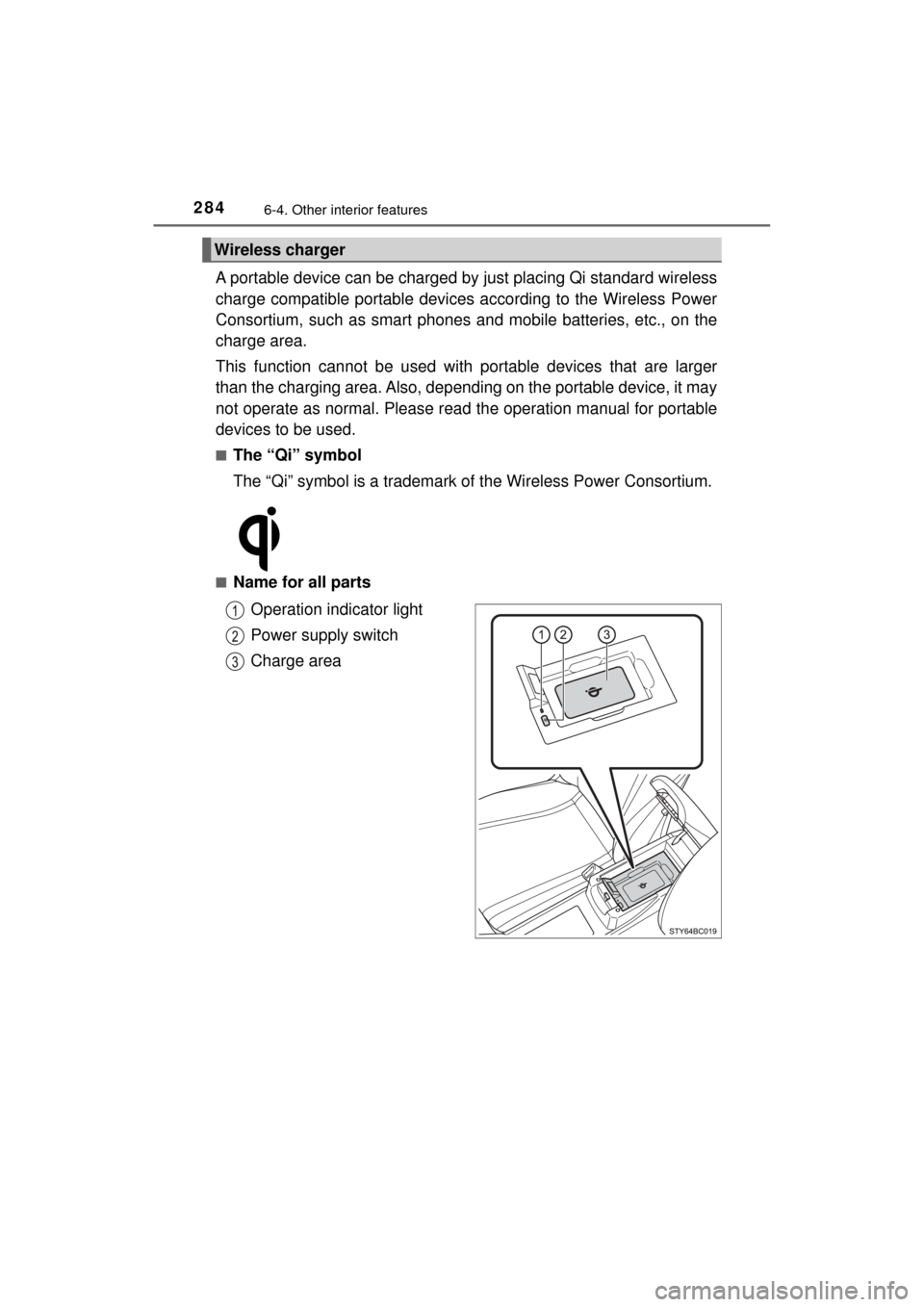
2846-4. Other interior features
MIRAI_OM_USA_OM62023U
A portable device can be charged by just placing Qi standard wireless
charge compatible portable devices according to the Wireless Power
Consortium, such as smart phones an d mobile batteries, etc., on the
charge area.
This function cannot be used with portable devices that are larger
than the charging area. Also, depend ing on the portable device, it may
not operate as normal. Please read the operation manual for portable
devices to be used.
■The “Qi” symbol
The “Qi” symbol is a trademark of the Wireless Power Consortium.
■Name for all parts
Operation indicator light
Power supply switch
Charge area
Wireless charger
Page 285 of 464
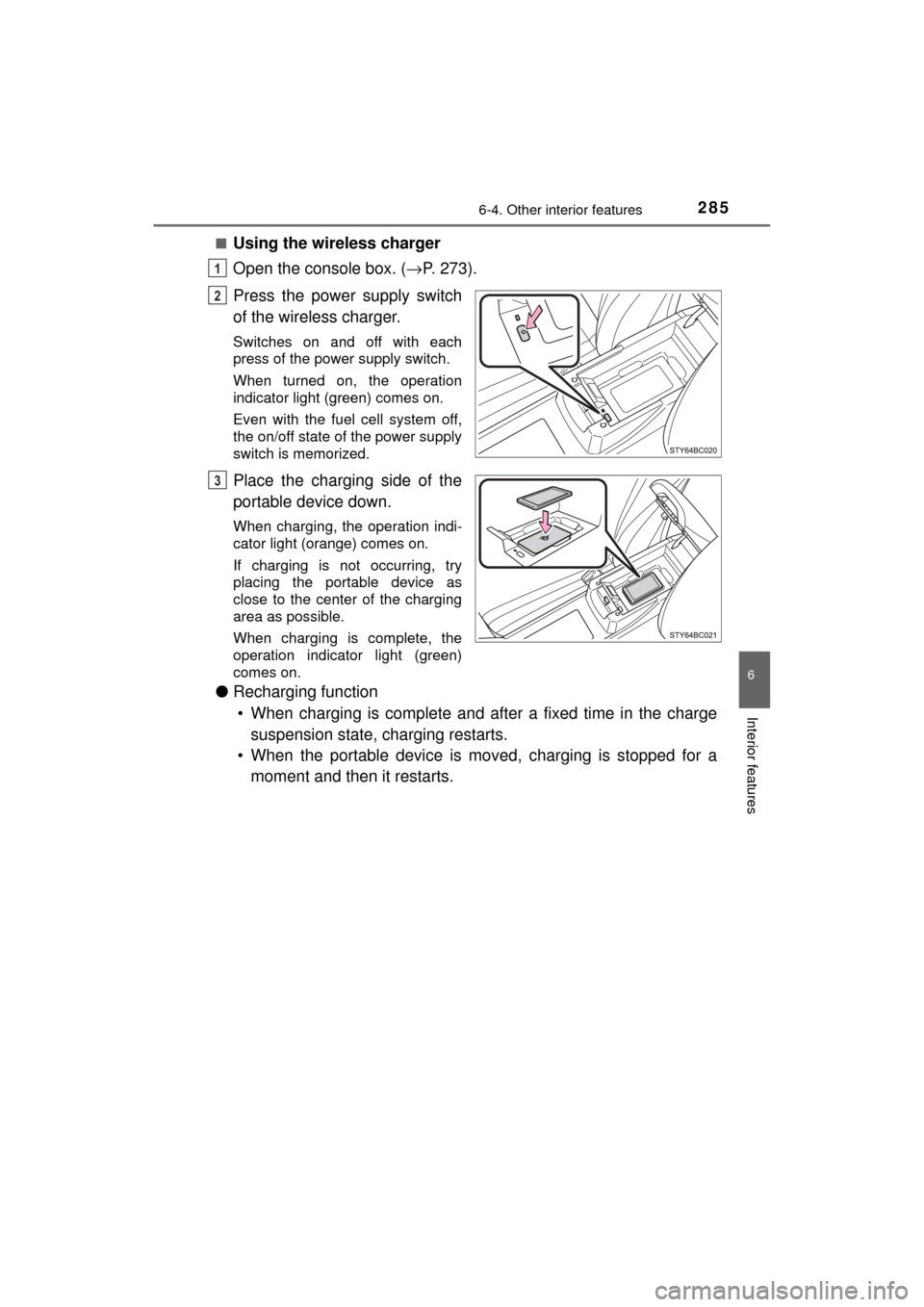
2856-4. Other interior features
6
Interior features
MIRAI_OM_USA_OM62023U■
Using the wireless charger
Open the console box. (→
P. 273).
Press the power supply switch
of the wireless charger.
Switches on and off with each
press of the power supply switch.
When turned on, the operation
indicator light (green) comes on.
Even with the fuel cell system off,
the on/off state of the power supply
switch is memorized.
Place the charging side of the
portable device down.
When charging, the operation indi-
cator light (orange) comes on.
If charging is not occurring, try
placing the portable device as
close to the center of the charging
area as possible.
When charging is complete, the
operation indicator light (green)
comes on.
● Recharging function
• When charging is complete and after a fixed time in the charge suspension state, charging restarts.
• When the portable device is mo ved, charging is stopped for a
moment and then it restarts.
1
2
3